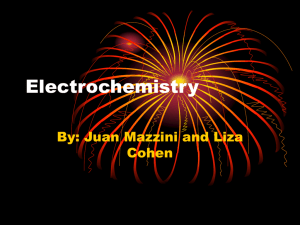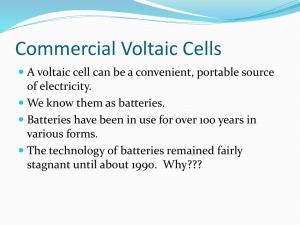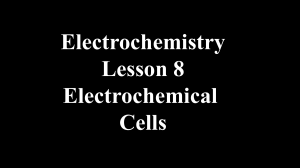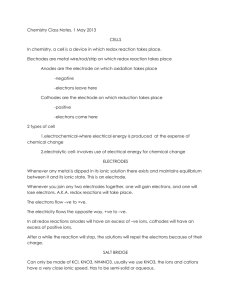Thermochemistry (4 lectures)
advertisement
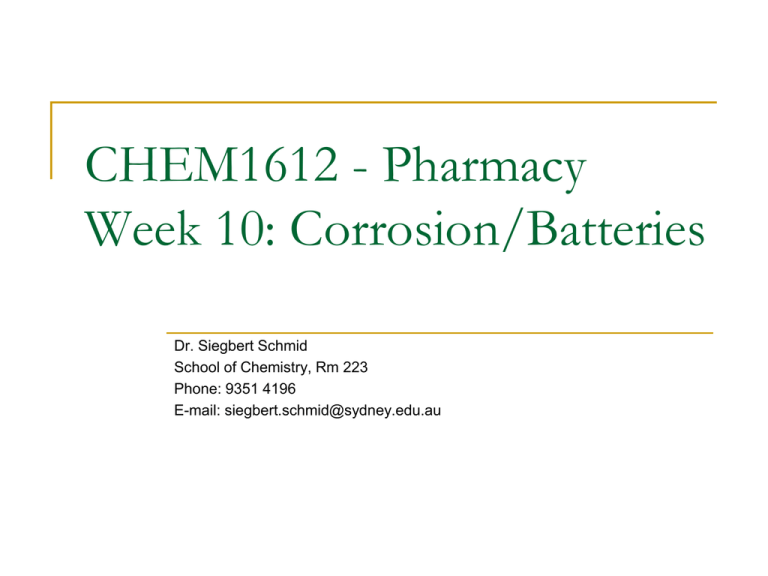
CHEM1612 - Pharmacy
Week 10: Corrosion/Batteries
Dr. Siegbert Schmid
School of Chemistry, Rm 223
Phone: 9351 4196
E-mail: siegbert.schmid@sydney.edu.au
Unless otherwise stated, all images in this file have been reproduced from:
Blackman, Bottle, Schmid, Mocerino and Wille,
Chemistry, John Wiley & Sons Australia, Ltd. 2008
ISBN: 9 78047081 0866
Electrochemistry
Blackman, Bottle, Schmid, Mocerino & Wille:
Chapter 12, Sections 4.8 and 4.9
Key chemical concepts:
Redox and half reactions
Cell potential
Voltaic and electrolytic cells
Concentration cells
NaCl
Key Calculations:
Calculating cell potential
Calculating amount of product for given current
Using the Nernst equation for concentration cells
Lecture 29 - 3
Production of Aluminium
Al is an expensive metal because of the stability of its oxide Al2O3.
Al cannot be electrolysed from solution because H2O is preferentially
reduced (E0Al = -1.66 V; EH20= -0.42 V).
Al cannot be electrolysed from the pure oxide because it melts at too
high a temperature (2045 ºC).
In 1886, Hall and Herault independently developed a method for
electrolytic production of Al metal, that is still used today.
Hall-Herault process: dissolve Al2O3 in hot cryolite, Na3AlF6, which
reduces the melting point to about 900 ºC.
Lecture 29 - 4
Production of Aluminium
Hall-Herault process
Figure from Silberberg, “Chemistry”,
McGraw Hill, 2006.
Graphite-lined furnace
At the anode graphite is oxidised to CO2 (as a result the electrodes are
rapidly used up), and fluoro-oxy ions are transformed in Al fluorides. Very
high currents are used (~250,000 A) on an industrial scale.
Lecture 29 - 5
Refining of Cu
http://electrochem.cwru.edu/ed/encycl/fig/m02/m02-f06b.jpg
Electro-refining is the principle method by
which Cu is refined to high purity.
Less easily
reduced
metals remain
in solution.
Noble
metals are not
oxidised, so
fall to the
bottom as
“mud”.
Lecture 29 - 6
Corrosion: Unwanted voltaic cells
The reduction of a metal oxide to a metal requires a lot of energy.
This means that the reverse, oxidation of a metal to its oxide will be
exothermic, and likely to be spontaneous.
Reduction + energy
Metal
Metal
oxide
Oxidation, spontaneous
Economically, the most important corrosion process is that of iron or steel.
Lecture 29 - 7
Corrosion
Iron roof
Corrosion is the process by which metals
are oxidised in the atmosphere.
In corrosion, a metal can act as both an anode and a cathode.
The electrons released at the anode travel through the metal to the
cathode.
Eo for the reaction is positive (a spontaneous process, product favoured).
Al, Ti, Cr, Ni and Zn do not corrode (much) because they form an
impervious oxide layer.
Corrosion results in loss of structural strength.
Lecture 29 - 8
The Mechanism of Corrosion
1) Oxidation of Fe at active anode forms a pit and yields e- which travel
through the metal
2) Electrons at the Fe (inactive) cathode
reduce O2 to OH3) Fe2+ migrates through
the drop and reacts with
OH- and then O2 to form
rust.
Lecture 29 - 9
Redox chemistry of corrosion
The rusting of iron involves two (or more) redox reactions:
Anode:
Cathode:
2 x {Fe Fe2+ + 2e-}
O2 + 4H+ + 4e- 2H2O
E ox0 = 0.44 V
E 0 = 1.23 V
The Fe2+ is further oxidised at the edges of the droplet, where [O2] is highest:
Anode:
Cathode:
2 x {Fe2+ Fe3+ + e-}
½ x {O2 + 4H+ + 4e- 2H2O}
Eox 0 = -0.77 V
E 0 = 1.23 V
Iron (III) forms a very insoluble oxide (rust) which is deposited at the edge:
2Fe3+(aq) + (3+n) H2O(l) Fe2O3•n H2O(s) + 6H+(aq)
Lecture 29 - 10
Chemistry of corrosion
You should now be able to explain some of the known features of rusting:
Why does iron not rust in dry air?
No water no “salt bridge”
Why does iron not rust in oxygen-free water, such as ocean depths?
No oxygen no oxidant
Why does iron rust more quickly in acidic environments?
H+ is a catalyst
Why does iron rust more quickly at the seaside?
More conductivity in the “salt bridge”
Lecture 29 - 11
Protection against corrosion
Fe can be protected by preventing O2 and H2O from reaching the metal,
by oiling the surface or coating with a thin film of metal oxide.
Anything more readily oxidised than Fe will act as anode and prevent Fe
from oxidising.
These sacrificial anodes can be made of any metal that is a stronger
reducing agent than Fe (“Activity Series of Metals”: Zn and Mg).
This is called “cathodic protection”, and is used frequently in large iron
structure such as ships, pipes, bridges, etc
Zinc anode
Bronze rudder
Lecture 29 - 12
Galvanic Corrosion
Stainless steel hanger
Mild steel bolts
Aluminium karabiner
Mild steel karabiner
Lecture 29 - 13
Images from http://www.theleedswall.co.uk/ymc/boltfund.htm
Batteries
Commercial use of redox reactions
3 classes of batteries:
Primary batteries: Non-rechargeable (e.g. alkaline battery)
Secondary batteries: Rechargeable (e.g. lead-acid, Ni-Cd, Li-ion
batteries)
Fuel cells: Fuel (e.g. H2/O2) pass through the cell, which converts
chemical energy into electrical energy.
Lecture 29 - 14
Primary Batteries
Alkaline battery
Use a solid alkaline electrolyte
paste (KOH) .
Cannot be recharged, it is “dead”
when its components reach
equilibrium concentrations.
Anode:
Zn + 2OH- ZnO + H2O + 2e-
Eox0 = 1.25V
Cathode:
2MnO2 + H2O + 2e- Mn2O3 + 2OH-
E0 = 0.12V
Overall:
Lecture 29 - 15
Secondary Batteries
Lead-acid battery (rechargeable)
Used to start cars.
The battery is recharged (turning it
into an electrolytic cell) to re-establish
non-equilibrium concentrations.
Anode:
Pb + HSO4- PbSO4 + H+ + 2eCathode: PbO2 + 3H+ + HSO4- + 2e- PbSO4 + 2H2O
Eox0=0.30 V
E0=1.63 V
Lecture 29 - 16
Fuel Cells
A fuel cell is a voltaic cell where the reactants are a combustible fuel, e.g. H2,
CH4. The fuel undergoes a normal (overall) combustion reaction, however the
two half-reaction are separated and the electrons harnessed.
Fuel cells are still in the experimental stage, and their most notable success is
probably for production of energy and water in space .
Anode:
Cathode:
H2 2H+ + 2e-;
½O2 + 2H+ + 2e- H2O;
Anode:
Cathode:
CH4 + 2H2O CO2 + 8H+ + 8e-;
4 x {½O2 + 2H+ + 2e- H2O};
E0=0.0 V
E0=1.23 V
Eox0=-0.3 V
E0=1.23 V
Lecture 29 - 17
Hydrogen fuel cell
• Efficient
• No pollutants
←e-
• Newer designs use
polymer electrolyte
membrane that ferries
H3O+ groups across
Pt catalyst surrounding
graphite electrode
Lecture 29 - 18
Li-ion batteries
On
discharge
Li-ions
move from anode to
cathode.
On charge Li-ions move
from cathode to anode
In the case of LiCoO2 the
battery is supplied in its
discharged state.
Lecture 29 - 19
Summary of Electrochemistry Concepts
Redox reactions
Standard reduction potential, E0
Reference electrodes
Galvanic cells, cell notation, and electromotive force Ecell
Electrolytic cells and Faraday’s Law
Nernst Equation and concentration cells
Examples of biological concentration cells
Relationship between E0, ΔG, Q, and K
Corrosion
Batteries
Lecture 29 - 20
